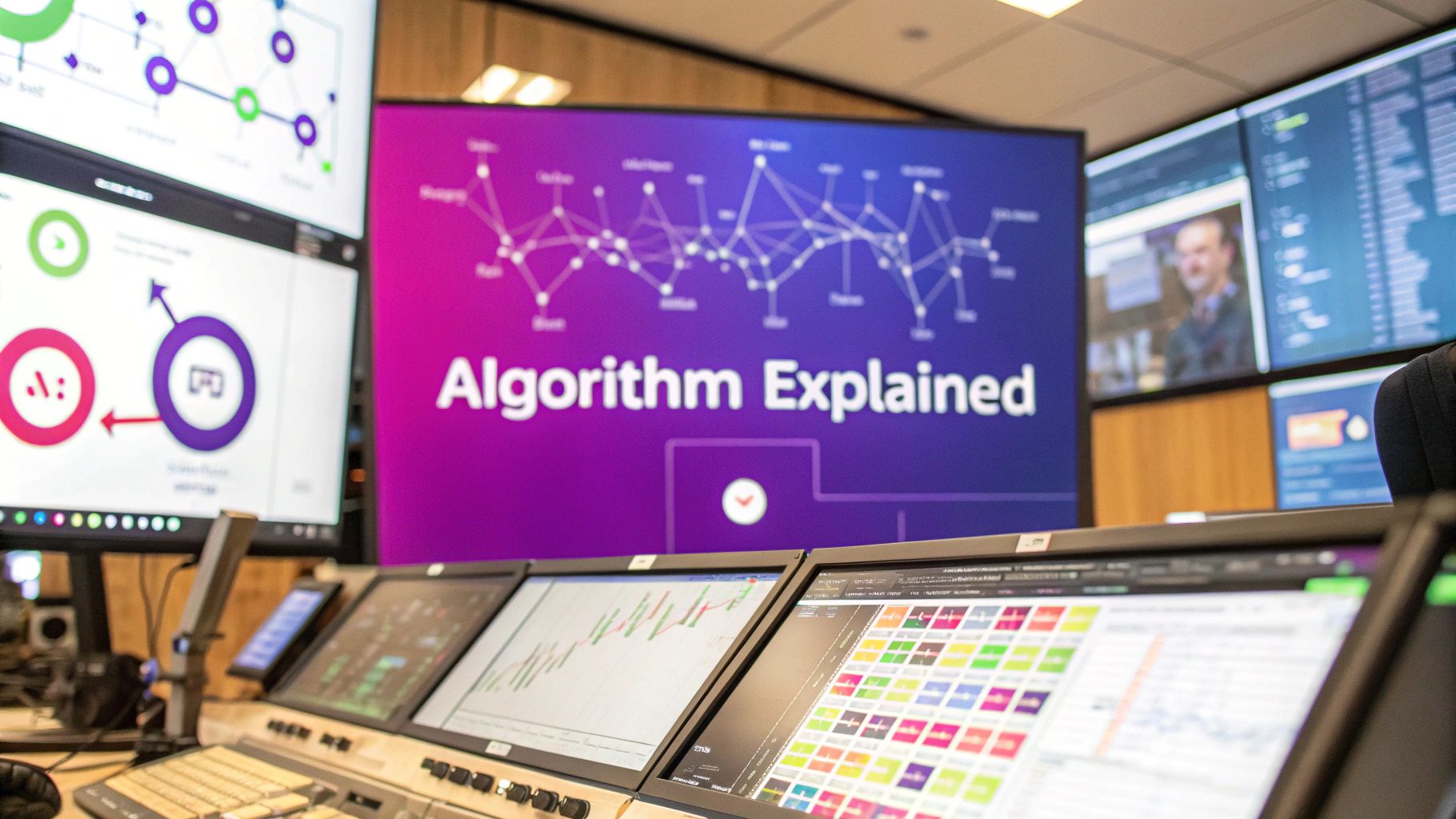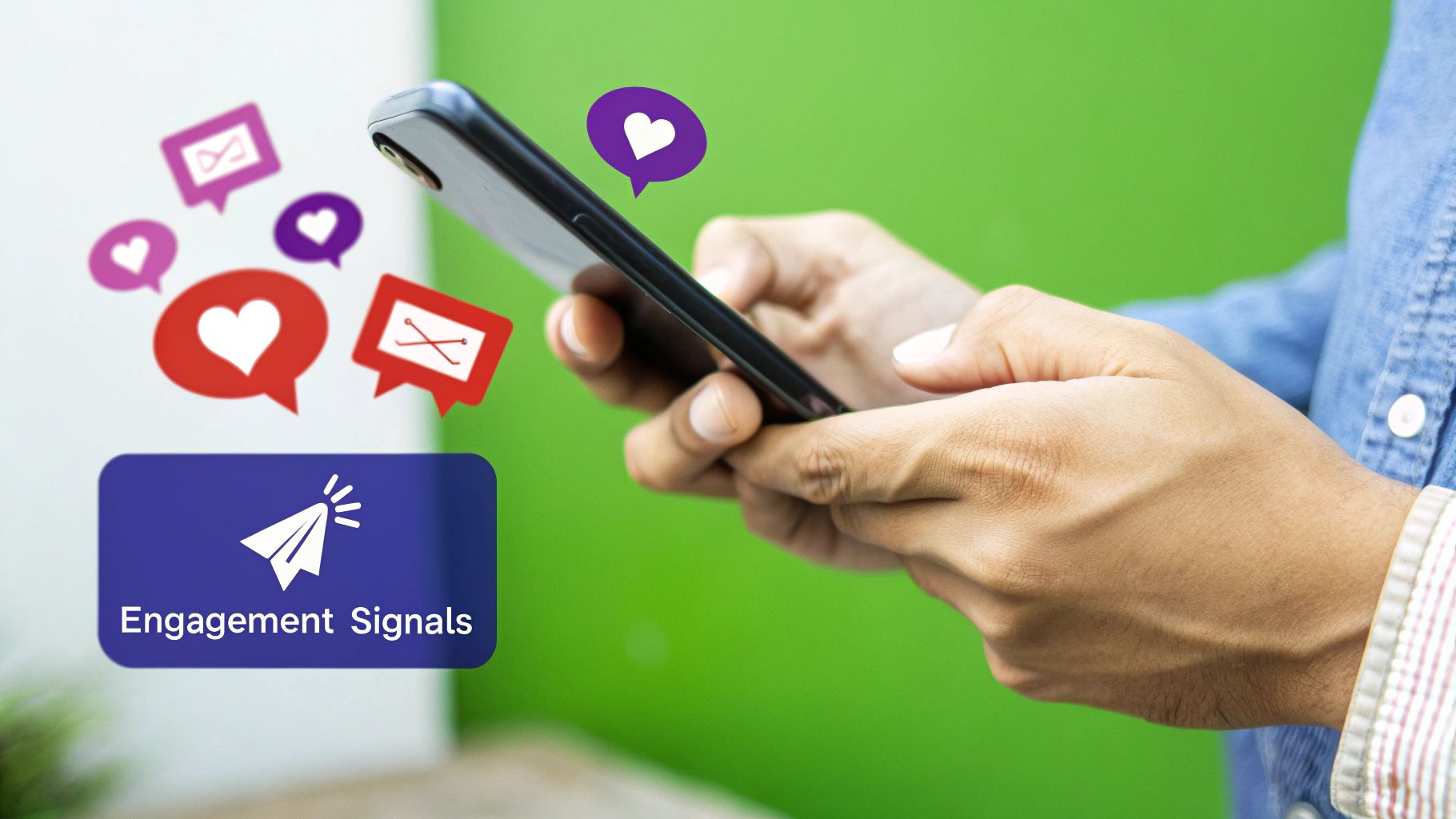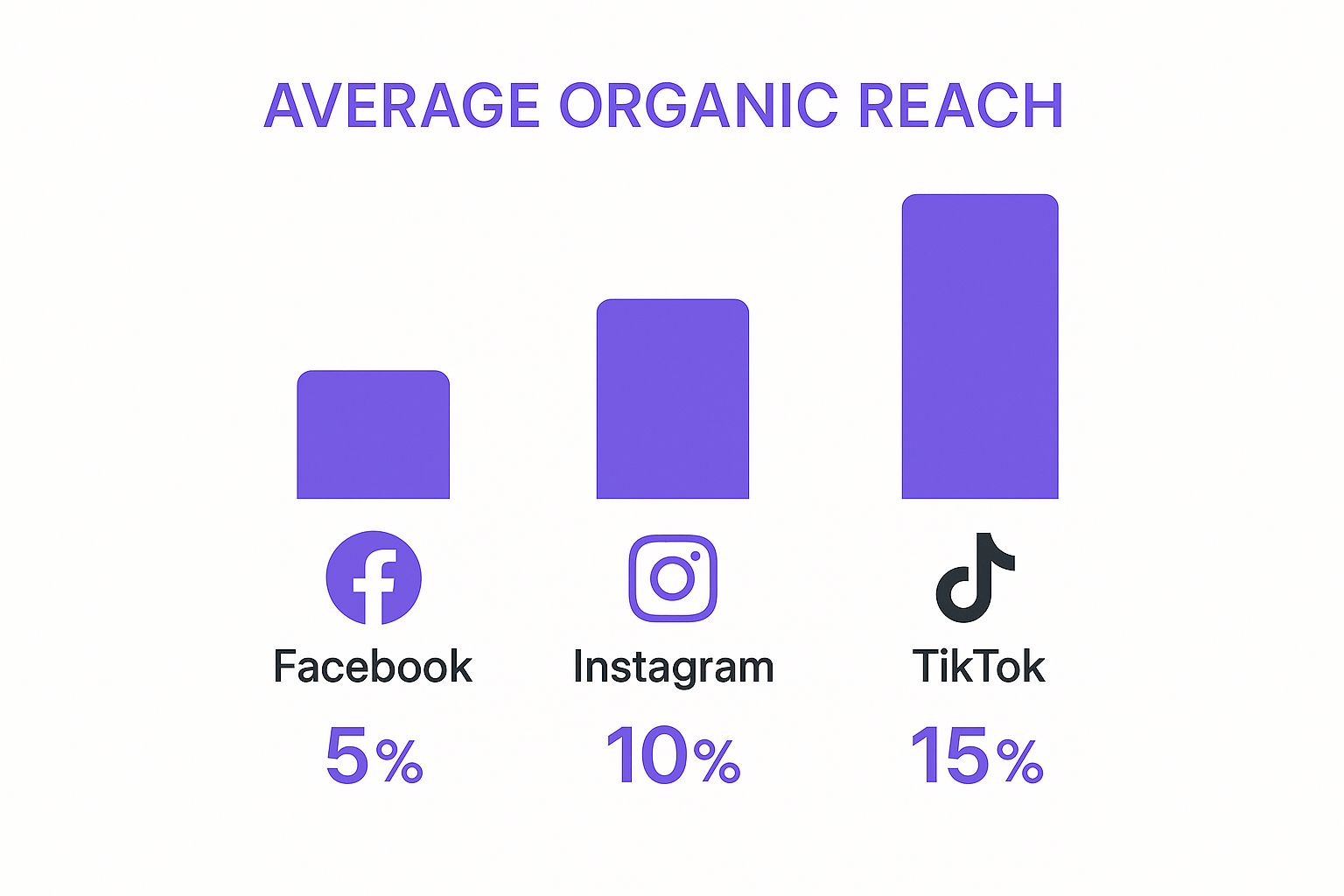Social Media Algorithm Explained

Think of a social media algorithm as your own personal content DJ. But instead of just spinning random tracks, this DJ knows your exact taste, curating a perfect playlist based on what you listen to, what you skip, and what you put on repeat. That's essentially what an algorithm does for your feed—it sifts through a sea of content to serve up what it thinks you'll find most interesting.
The Architect Behind Your Digital World

At its heart, a social media algorithm is just a complex set of rules and data points that platforms use to make your experience unique. Gone are the days of a simple chronological timeline where you just saw the newest post first. Now, the algorithm acts as a sophisticated gatekeeper, and its main job is to build a compelling, custom-tailored feed for every single user to keep them scrolling.
This system is constantly learning from everything you do. Every like, share, and comment sends a signal. Even how long you pause on a video tells the platform something important. Think of it as an ongoing conversation between you and the app; your actions are the feedback, and the algorithm adjusts the content it shows you in return.
Why Do Algorithms Even Exist?
The move to algorithmic feeds was a direct response to a massive problem: information overload. As platforms exploded in popularity, chronological feeds became chaotic and overwhelming. It was far too easy to miss posts from the people you actually cared about. Algorithms were designed to fix that by prioritizing content it predicts will be meaningful to you.
Ultimately, the goal for any social media platform is to keep you engaged. A highly personalized feed does this by showing you content that:
- Sparks emotion: Posts that make you laugh, think, or feel something.
- Strengthens connections: Updates from the friends and family you interact with most often.
- Aligns with your interests: Content related to your hobbies, news sources, and the creators you follow.
By understanding and predicting user behavior, algorithms transform a chaotic stream of information into a curated digital experience designed to hold your attention.
Getting a handle on these systems is the cornerstone of any modern digital strategy. A solid grasp of how they work is fundamental to successful social media optimization, giving creators and brands a real shot at boosting their visibility. This guide will break down exactly how the algorithms behind your favorite platforms really work.
The Shift from Chronological to Curated Feeds

To really get how today’s social media algorithms work, you have to go back in time. In the early days, platforms like Facebook and Twitter were dead simple. Your feed was just a straightforward, reverse-chronological stream of posts—whatever was newest sat right at the top. It was fair, easy to grasp, and it worked like a charm back when you only followed a handful of friends.
But that digital paradise couldn’t last. As these networks exploded from cozy communities into global giants, the chronological model started to buckle. Users were suddenly connected to hundreds, then thousands, of friends, brands, and creators. The sheer volume of content turned from a stream into a tidal wave.
This created a huge problem: information overload. The average person could have thousands of new posts waiting for them every single day, making it impossible to keep up. The experience wasn't fun anymore; it was just overwhelming. Important updates from your actual friends were getting buried under a flood of memes, ads, and vacation photos from people you barely knew. The platforms knew they were staring down an engagement crisis.
The Rise of Algorithmic Curation
To fix this mess, the platforms needed a smarter system. The mission was to rescue the most relevant, interesting content from all the noise and make sure people saw what actually mattered to them. This need sparked the single biggest evolution in social media history: the switch from chronological timelines to algorithmically curated feeds.
The idea was a game-changer. Instead of just showing you everything as it happened, the platform would act like your own personal editor, using your behavior to predict what you’d want to see most. This wasn't about hiding content—it was about highlighting the best of it.
Facebook led the charge. While things started chronologically, the platform’s massive scale made it clear a new approach was needed. By 2009, Facebook began its pioneering shift to a personalized, algorithm-based feed that valued relevance over recency. This move was a direct response to the content explosion, as the old feeds just couldn't keep users engaged anymore.
Algorithms started analyzing everything—likes, shares, comments, even how long you hovered over a post—to figure out what was most valuable to each individual. Facebook’s success set the new standard, and by 2016, networks like Instagram and Twitter followed suit, making the curated feed the norm. You can dig into a deeper history of these changes to see how they shaped the platforms we use today.
Why the Change Was Inevitable
Honestly, the move to algorithmic feeds was a survival mechanism. Without it, user satisfaction would have cratered, and people would have just stopped logging in. The chronological feed was a nice democratic idea, but the curated feed was a practical necessity.
Think of it this way: the chronological feed was like trying to drink from a firehose. It was just too much, too fast. The algorithm became the person pouring you a glass of water instead—delivering a much more manageable and satisfying experience.
Key Takeaway: The social media algorithm wasn't born to be a mysterious gatekeeper. It was created as a solution to information overload, making massive platforms usable and enjoyable again by prioritizing personal relevance over simple timeliness.
This fundamental shift is the "why" behind every social media algorithm out there. Each platform's system is just an attempt to perfect this curation process, constantly learning from your interactions to build a feed that feels like it was made just for you. Understanding this origin story is the first real step to mastering your content strategy.
Understanding Core Ranking Signals

While every social media platform guards its algorithm like a secret family recipe, they all start with the same basic ingredients. These are the core ranking signals, the universal building blocks that help the system decide what’s worth showing you.
Think of them as the algorithm's DNA—a fundamental code that dictates what thrives in the feed and what gets buried.
Once you get a handle on these signals, the whole game changes. Instead of throwing content at the wall and hoping something sticks, you can create posts that naturally align with how these platforms are built to think. At the highest level, these signals fall into three main categories.
To make this crystal clear, let's break down how these signals work together. Think of them as the three pillars holding up the entire content ranking system.
The Three Pillars of Content Ranking
| Signal Category | What It Means for the Algorithm | Examples of User Actions |
|---|---|---|
| Relationship | The algorithm prioritizes content from accounts it believes you have a strong connection with. | Sending DMs, commenting frequently, visiting a profile, tagging someone. |
| Interest | The system analyzes the post's topic to see if it matches your demonstrated interests. | Liking posts about a specific topic, following certain hashtags, searching for keywords. |
| Recency | Newer, timely content is often given an initial boost over older posts. | Posting when your audience is most active, engaging with trending topics. |
By keeping these three pillars in mind, you can start to see why some content performs better than others. It's rarely a single factor, but rather a combination of all three working in tandem.
Pillar 1: The Relationship Signal
First and foremost, the algorithm is a social matchmaker. It pays incredibly close attention to who you interact with and prioritizes content from accounts it thinks you have a genuine connection with. Your past interactions are its best predictor of what you’ll want to see next.
Imagine you’re at a huge party. You’re far more likely to tune into a conversation with a close friend than a stranger shouting in the corner. That’s exactly how the algorithm operates—it assumes you care more about people you already engage with.
So, what actions scream "strong relationship" to the algorithm?
- Direct Messages (DMs): Sending a DM is one of the most powerful signals. It tells the platform this is a 1:1 connection you value.
- Frequent Engagement: Consistently liking, commenting on, or sharing an account's posts shows an active, ongoing interest.
- Profile Visits: The algorithm notices when you intentionally seek out a specific profile to see what they’ve been up to.
This is why a thoughtful comment will always send a stronger signal than a passive "like." Building a real community isn't just a feel-good strategy; it's a direct line to the algorithm's heart.
Pillar 2: The Interest Signal
Next up, the algorithm plays detective, analyzing the content itself to figure out if it aligns with things you’ve shown interest in before. It’s not just about who posted it, but what the post is actually about.
The system acts like a hyper-efficient librarian. It meticulously catalogs every single post by topic, from baking tutorials to vintage car restorations. When you repeatedly check out "books" from a certain shelf, it naturally starts recommending more from that same section.
How does it figure out what you're into?
- Keyword and Hashtag Analysis: It scans captions, text overlays on videos, and hashtags to understand the post's subject matter. This is why using relevant keywords is so important for getting discovered.
- Visual Recognition: Modern algorithms use AI to identify objects, scenes, and even text within images and videos, adding another layer of contextual understanding. A picture of a golden retriever on a beach gets tagged with "dog," "beach," "pet," and "ocean."
- Engagement History: If you consistently interact with posts about a certain topic—say, home renovation—the algorithm will start feeding you more of that content from a wider range of creators.
By understanding the topics and formats you prefer, the algorithm builds a detailed profile of your interests, ensuring your feed is filled with content you're likely to find relevant and engaging.
Pillar 3: The Recency Signal
Finally, while the chronological feed is mostly a thing of the past, recency still matters. A lot. Algorithms want to show users what’s fresh and happening now. An older post, even a high-performer, will eventually lose momentum to make way for newer updates.
This is why timing your posts is so crucial. Sharing content when your audience is most active online gives it an immediate burst of engagement, signaling to the algorithm that this post is hot right now. To give your content a critical head start, it pays to learn the best times to post on social media.
These three pillars—Relationship, Interest, and Recency—are the foundation. They work together to curate the feed you see every day. But the system is always getting smarter. Today’s algorithms use machine learning to rank content based on much deeper signals, like how long you watch a video versus just scrolling past it. The constant evolution of these platforms means our strategies have to evolve, too.
How Each Major Platform's Algorithm Is Different
Trying to use the same content strategy across every social network is a bit like using one key for a dozen different locks. It just won’t work. Each platform's algorithm has its own personality, shaped by its business goals and what its users have come to expect. Getting a feel for these differences is the first step to creating content that actually connects.
Sure, they all use the same core signals—relationship, interest, and recency—but how they weigh those signals is a completely different story. Some platforms are all about discovery and pure entertainment, while others are built for professional networking or deep community chats. This is exactly why a video that blows up on TikTok might get nothing but crickets on LinkedIn.
To win, you have to learn to speak each algorithm's native language. Let's break down what the major players are really looking for, so you can stop guessing and start tailoring your approach for maximum impact.
Before we dive into the nitty-gritty of each platform, it's helpful to see how their core priorities stack up against each other. Each algorithm is fine-tuned for a specific goal, which in turn dictates the kind of content that gets rewarded with reach.
Algorithm Priorities Across Major Platforms
This table gives you a high-level look at what each major social network's algorithm is trying to achieve and what content it favors as a result.
| Platform | Primary Algorithmic Goal | Key Content Factors |
|---|---|---|
| Keep users engaged across multiple formats (Feed, Stories, Reels). | Feed/Stories: Relationships & Recency. Reels: Watch time & Entertainment. | |
| TikTok | Maximize user watch time through hyper-personalized discovery. | Video completion rates, shares, comments, trending audio. |
| Foster "Meaningful Social Interactions" between users. | Comments, replies, and shares that spark conversations. | |
| Surface valuable professional insights and career-related content. | Early engagement (first hour), industry relevance, professional tone. |
As you can see, a one-size-fits-all approach is doomed from the start. A strategy built for sparking conversations on Facebook will fall flat on a discovery-focused platform like TikTok. Now, let’s get into the specifics for each one.
Instagram: A Multi-Faceted System
Instagram doesn't have a single, all-powerful algorithm. Instead, think of it as a team of specialists, each managing a different part of the app to keep you hooked in its own unique way. This means your game plan for Stories needs to be totally different from your strategy for Reels.
The main Feed and Stories algorithms are all about showing you content from people you already know and like. They look at who you interact with the most—through likes, comments, DMs, and even profile visits—to surface posts from the friends, family, and creators you care about. Freshness is a big deal here, too.
The Reels algorithm, on the other hand, is built for pure entertainment and discovery. Its main job is to find short, captivating videos from accounts you might not even follow. It’s laser-focused on signals like:
- Watch Time: Did someone watch your video all the way through? Even better, did they watch it again?
- Engagement: Likes, comments, shares, and saves are all strong indicators of a great Reel.
- Audio Usage: If someone taps the audio page from your Reel, it tells the algorithm they might want to create their own video with that sound.
Finally, you have the Explore page algorithm, which acts as your personalized window into new content. It recommends posts based on your past activity, showing you things from accounts that are similar to the ones you already engage with. Landing on Explore is a massive win for reaching a new, highly relevant audience.
TikTok: The Ultimate Discovery Engine
TikTok’s "For You Page" (FYP) is, without a doubt, the most powerful discovery engine in social media today. Unlike other platforms that are heavily biased toward your existing friends and followers, TikTok is famous for its ability to take a brand-new creator with zero followers and make them go viral overnight.
It puts content signals above everything else, curating a feed based entirely on what it thinks you'll find entertaining.
The TikTok algorithm cares less about who you know and more about what you like. It builds a highly personalized stream of content based on micro-signals from your viewing behavior, creating an incredibly addictive discovery experience.
The key signals here are things like video completion rate, shares, comments, and whether you're using trending sounds and effects. The algorithm learns your tastes incredibly fast, serving up a never-ending buffet of content perfectly suited to you. This makes it a place where truly creative ideas can explode, regardless of who's behind them.
Facebook: Sparking Meaningful Conversations
Facebook's algorithm has changed a lot over the years. It's moved away from prioritizing public content from brands and publishers and now focuses on posts that create personal connections between people. Its core mission is to drive "Meaningful Social Interactions" (MSI).
This means the algorithm now heavily favors content from your friends, family, and the Groups you're most active in. For brands and creators, that’s a tough nut to crack. To get any traction, your content has to be something that actively sparks conversation. The algorithm is looking for:
- Comments and Replies: Posts that create a real back-and-forth discussion get a huge boost.
- Shares to Messenger: When someone shares your post privately with a friend, it’s a powerful signal that the content is personally relevant.
- Active Engagement: Thoughtful reactions and long-form comments are worth way more than a simple "like."
If you’re just posting promotional fluff that doesn't invite a response, expect your reach to be throttled. The key to the Facebook algorithm is simple: make stuff that gets people talking to each other.
LinkedIn: The Professional Gatekeeper
The LinkedIn algorithm is designed to be a professional gatekeeper, curating a feed filled with valuable industry insights, career advice, and relevant news. It’s not the place for memes or vacation photos. The goal is to connect professionals and spark meaningful conversations within their fields.
When you first post something, the algorithm shows it to a small test group of your connections. It then carefully watches how that post performs in the first hour. Early likes, comments, and shares are absolutely critical. If that initial response is strong, LinkedIn will start pushing it to a much wider audience. A key part of your strategy here involves maintaining a consistent and professional brand, which requires a solid grasp of your social media branding.
This "relevance-first" model became the industry standard around 2016, with Instagram and Twitter following suit. This shift fueled explosive growth for platforms that nailed content discovery. Instagram's user base shot past 1 billion monthly active users by 2023, largely because its algorithm got so good at showing people what they wanted to see. In the same vein, TikTok’s "For You Page" perfected AI-driven video recommendations, powering its own meteoric rise to over 1 billion active users by 2022.
This image really drives home how these different priorities affect something as critical as organic reach.

The data makes it crystal clear. Platforms built for discovery, like TikTok, tend to offer much higher average organic reach. On the flip side, networks that prioritize interactions within a closed circle of friends, like Facebook, make it much harder to reach new people without paying.
Strategies to Improve Your Content's Performance
Knowing how the algorithms work is one thing. Actually using that knowledge to grow your account is a totally different ballgame. It’s time to move past vague advice like “be authentic” and focus on real, tangible actions that send all the right signals to these complex systems.
The goal here is simple: create content that naturally clicks with what each algorithm wants to promote. This isn't about gaming the system, but about making posts that don't just get seen—they get a reaction. You want to spark the very interactions that algorithms are designed to measure and reward.
Spark Conversations to Boost Engagement
One of the strongest signals you can send an algorithm is that your content gets people talking. A huge part of a creator's job is to figure out how to increase social media engagement, because it's a massive factor in getting the algorithm on your side. Platforms like Facebook have been very open about prioritizing posts that generate real back-and-forth conversations.
To pull this off, you need to start thinking like a community manager.
- Ask Open-Ended Questions: Ditch the simple yes/no questions. Pose a query that makes people think. A travel blogger could ask, "What's one destination that completely surprised you and why?" instead of "Have you been to Paris?"
- Use Engaging Calls-to-Action (CTAs): Go beyond the tired "link in bio." Encourage specific actions, like "Tag someone who needs to see this," or "Drop your best tip in the comments below."
- Create Polls and Quizzes: Features like Instagram Story polls are super low-effort ways for your audience to engage. Every single vote sends a positive signal to the algorithm.
When you prompt these kinds of interactions, you're doing more than just juicing your metrics. You're building a genuinely active and loyal community around what you create.
Create Content Worth Saving and Sharing
Likes and comments are great, but saves and shares are often the gold standard for algorithms. A "save" tells the platform your content is so useful that someone wants to come back to it later. A "share" is even better—it means your post was valuable enough for someone to broadcast it to their own network.
This is where the strategy of creating "saveable" content really shines. Think about content that offers lasting value long after it's posted.
- Tutorials and How-To Guides: A step-by-step guide on editing a photo or a quick recipe video is prime save-worthy material.
- Checklists and Resource Lists: A post titled "5 Books Every Entrepreneur Should Read" or "Your Ultimate Packing Checklist" is practically begging to be saved for future reference.
- Inspiring or Educational Carousels: Break down a big idea into bite-sized, digestible slides. Each slide gives another reason to save the whole post to learn from later.
When you're brainstorming new social media content ideas, always ask yourself this one simple question: "Is this genuinely useful enough for someone to save?"
Optimize for Watch Time on Video
On video-heavy platforms like TikTok and Instagram Reels, watch time is king. It's the metric that rules them all. The algorithm's number one job is to keep people on the app for as long as possible, so it aggressively pushes videos that prove they can hold an audience's attention.
The first three seconds of your video are everything. If you can't hook a viewer immediately, they're gone. They'll just scroll past, sending a negative signal to the algorithm that your content couldn't keep them engaged.
To get your watch time up, you need to nail two things:
- The Hook: Start with a bang. Use a strong visual, ask a provocative question, or make a bold statement right out of the gate. You have to create immediate curiosity and give people a reason to stick around.
- The Pacing: Keep things moving. Use quick cuts, text on screen, and dynamic shots to maintain visual interest. Long, static shots are a recipe for boredom and will send viewers scrolling.
Mastering the hook and keeping a snappy pace are non-negotiable skills for anyone serious about short-form video. You're feeding the algorithm exactly what it craves: content that keeps people watching.
Frequently Asked Questions About Social Media Algorithms
Trying to understand social media algorithms can feel like chasing a moving target. Even when you get the hang of the core signals and platform quirks, a few common questions and myths always seem to stick around. This section is all about giving you clear, direct answers so you can build your content strategy with confidence.
Let's cut through the noise and tackle the questions every creator and brand bumps into sooner or later. Think of this as your go-to cheat sheet for algorithmic truths.
Does Posting Time Still Matter with Algorithms?
Yes, but its role has definitely changed. A truly great piece of content will eventually find its audience no matter when you post, but posting when your followers are most active gives it a huge head start. It’s like launching a boat—you can do it at low tide, but launching at high tide is a whole lot easier.
Here's the deal: early engagement is a massive green flag for any algorithm. When your post goes live and immediately starts racking up likes, comments, and shares, it screams, "Hey, people are loving this right now!" That initial surge of activity gives it the momentum it needs to reach a wider audience, faster.
So, while content quality is king, timing is still a vital part of your strategy. Dive into your platform's analytics, pinpoint when your audience is scrolling, and schedule your posts to give them the best possible launchpad.
Are Hashtags Still Effective for Reach?
Absolutely. Used the right way, hashtags are still one of the best tools for discovery. They act like digital signposts, helping the algorithm categorize your content and serve it up to people who've shown interest in that topic. It's your ticket to reaching an audience beyond your existing followers.
The secret is relevance over quantity. Piling on dozens of generic tags like #love or #instagood is a waste of time. Instead, you need a smart mix:
- Broad Hashtags: These are the high-level tags for your industry (e.g.,
#DigitalMarketing). - Niche Hashtags: Get more specific here to target a smaller, more dedicated community (e.g.,
#ContentStrategyTips). - Community Hashtags: These are the tags used by specific groups or for events (e.g.,
#SocialMediaManagerLife).
A well-researched blend of hashtags connects you with new audiences who are actively looking for the exact content you're creating.
The most successful approach isn't about tricking the algorithm but aligning with its core purpose: to provide users with valuable, engaging, and relevant content. When you focus on creating posts that spark genuine connection, you naturally align your goals with the platform's, leading to sustainable growth.
Can You Beat the Social Media Algorithm?
Trying to "beat" or "trick" the algorithm is a losing game. Platforms pour massive resources into closing loopholes and penalizing sketchy behavior like buying followers or using engagement pods. Those short-term hacks almost always lead to long-term penalties, like getting your reach throttled or even your account suspended.
The only sustainable way forward is to work with the algorithm, not against it. That means doubling down on the fundamentals: creating high-quality, valuable content that your audience actually wants to see. A great starting point is to explore proven ways to boost your social media engagement, since that's what the algorithms are designed to reward.
Instead of hunting for shortcuts, pour that energy into understanding what your audience needs and creating content that serves them. When you consistently deliver value, you send the most powerful signals possible to the algorithm, building a loyal community and achieving real, lasting growth.
Ready to stop guessing and start creating a professional online presence that algorithms love? MakerBox uses AI to generate optimized bios, profile pictures, and engaging social media content tailored for your brand. Transform your profiles in seconds and watch your engagement soar. Elevate your online presence with MakerBox today!





